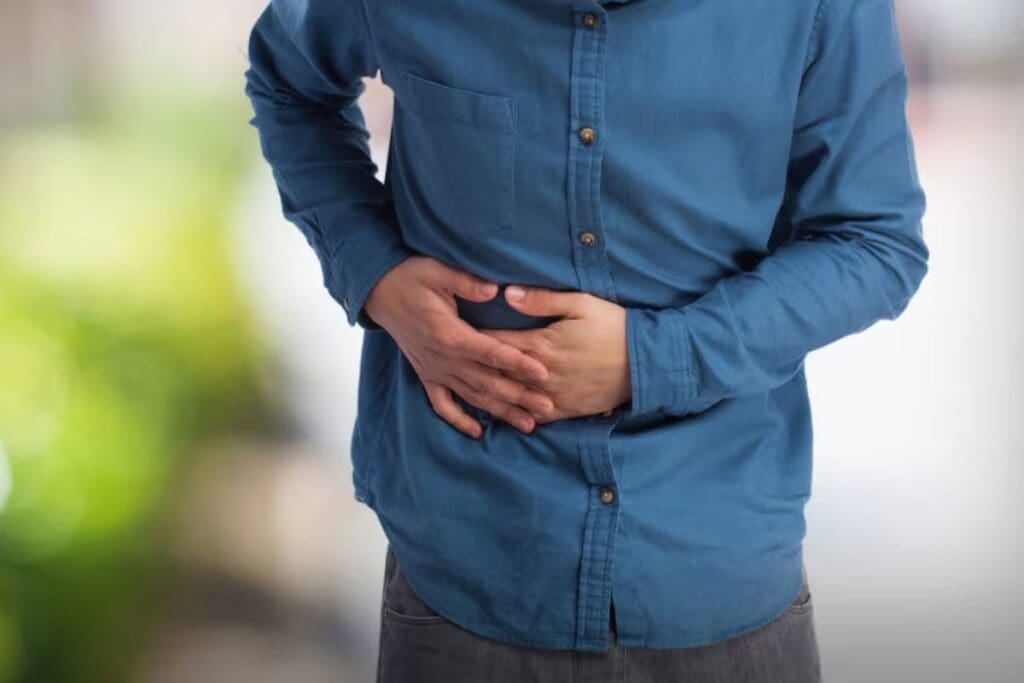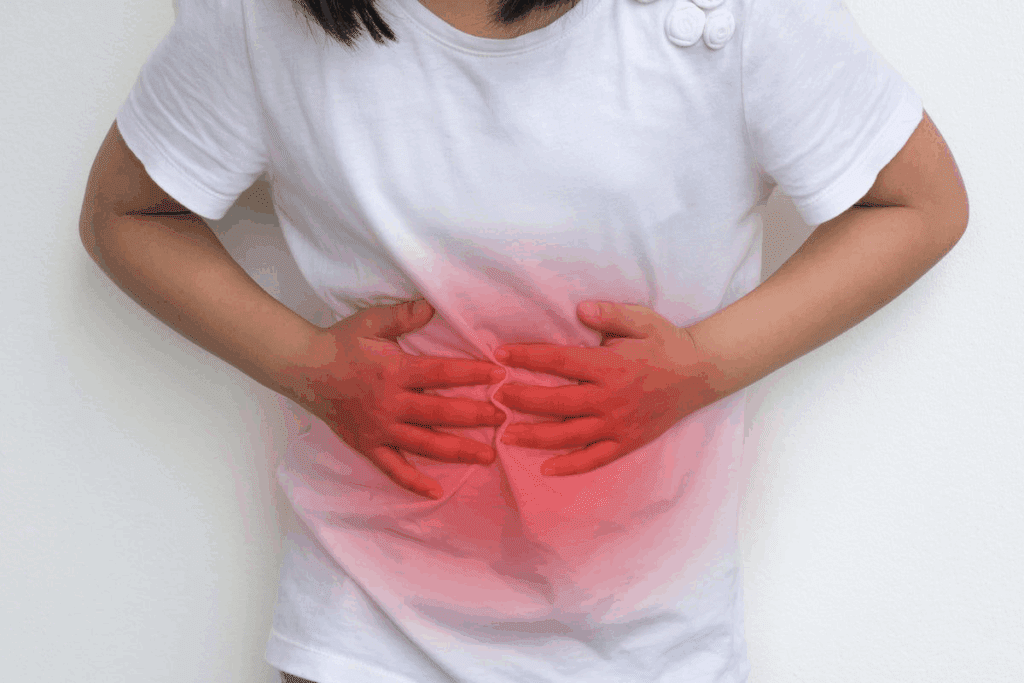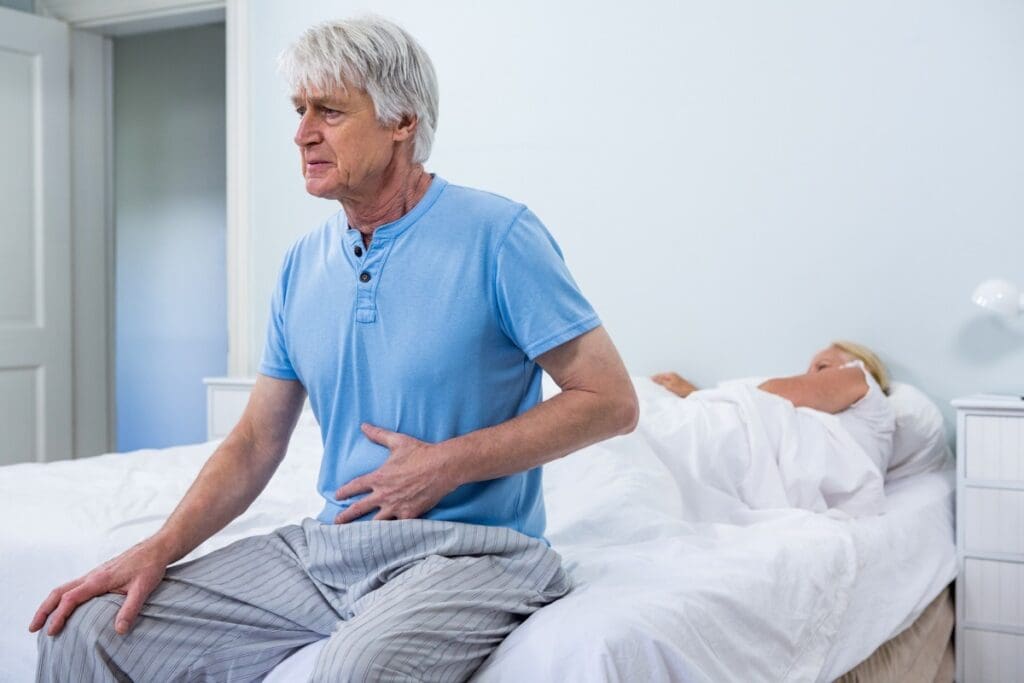Last Updated on November 26, 2025 by Bilal Hasdemir

Can you get gallstones after gallbladder removal? Yes. Discover the shocking risk, causes, and answers about post-surgery stones.
Some people are more likely to get gallstones. This includes women, people over 40, and those who are overweight or eat a lot of fat. Knowing the causes and risks is key to managing and reducing these risks.

Gallstones are often linked to the gallbladder, but they can also cause problems after it’s gone. It’s key to know what gallstones are, their health impact, and the gallbladder’s role in digestion.
Gallstones form when bile substances crystallize and solidify. Bile, made by the liver, helps digest fats. If gallstones block bile flow, they can cause severe pain and inflammation.
Gallstones can be asymptomatic for a long time, but symptoms often need medical help. Their main issue is causing blockages, inflammation, and infections in the biliary system.
The gallbladder stores bile under the liver. It’s not vital for digestion, but it helps concentrate bile for fat digestion. After removal, bile flows directly to the small intestine.
Cholecystectomy is a surgery to remove the gallbladder for pain or complications. It can be done laparoscopically or openly. Laparoscopic surgery is preferred for its quick recovery.
Understanding the implications of gallbladder removal is key for managing expectations and recognizing post-surgery complications. Cholecystectomy can solve gallbladder stone issues, but it doesn’t prevent bile duct stones.

Removing your gallbladder doesn’t mean you’re free from gallstone problems. Many people find out they can have symptoms like gallstones even after surgery.
It’s more common than you think to have gallstone-like symptoms or actual stones after surgery. This is often called post-cholecystectomy syndrome or retained stones.
Research shows that patients can get stones in their bile ducts after surgery. These stones can cause pain, jaundice, and nausea, just like before.
Studies show many patients keep having symptoms after surgery. Some symptoms come from stones in the bile ducts.
A study in a medical journal found up to 40% of patients have symptoms after surgery. Some of these are due to stones that stayed or came back.
The chance of getting stones after surgery varies. But it’s a big concern. Knowing the risks can help prevent these problems.
Looking at the research helps us understand gallstones and surgery better. It shows the complexity of gallstone formation and what happens after surgery.
Removing the gallbladder changes how the body digests food. The liver keeps making bile, which now goes straight to the small intestine. This can cause the body to adapt in different ways and lead to complications.
After the gallbladder is gone, the biggest change is where bile goes. It now flows from the liver into the bile ducts and then into the small intestine. This can sometimes cause digestion problems and bile duct stones.
Bile flowing directly into the intestine can change digestion. Some people might get diarrhea or have fatty stools. Changing your diet can help manage these symptoms and keep your digestive system healthy.
Most people adjust to life without a gallbladder by changing their habits. They eat smaller meals more often and avoid fatty foods. Over time, the body usually finds a new balance, but some might keep having digestive problems.
Bile duct stones can be a problem after the gallbladder is removed. These stones might have been missed during surgery or form later due to changes in bile flow.
Retained stones were missed during surgery and can move into the bile ducts. Newly formed stones develop after surgery, often because of changes in bile. Knowing where these stones come from is key to figuring out how to treat them.
Stones that form after gallbladder removal are different from those in the gallbladder. They might be made of different materials and have unique characteristics. This can affect how they are treated.
| Characteristics | Retained Stones | Newly Formed Stones |
| Origin | Missed during initial surgery | Formed after cholecystectomy |
| Composition | Similar to gallbladder stones | May differ, often related to bile composition changes |
| Treatment Approach | Often requires endoscopic removal | May involve medication or lifestyle changes |
Gallstones can form even after the gallbladder is removed. This is because of several reasons. The gallbladder’s absence changes how bile flows and is stored.
One main reason for gallstones after surgery is not removing all stones. If some stones stay, they can cause issues or move into the bile ducts.
Incomplete stone removal happens for many reasons. This includes where the stones are or how complex the surgery is.
Laparoscopic surgery can dislodge gallstones. These stones can then move into the belly or bile ducts. This can lead to new problems, like more stones forming.
Removing the gallbladder changes how bile flows and what it’s made of. Without a gallbladder, bile ducts must handle bile constantly. This can raise the risk of stones forming because of changes in bile.
| Factor | Effect on Bile |
| Continuous Bile Flow | Increased risk of bacterial contamination |
| Changes in Bile Composition | Potential for increased cholesterol or bilirubin concentration |
| Bile Duct Dilatation | Possible stagnation of bile, increasing the risk of stone formation |
Some body structures can also lead to gallstones after surgery. This includes bile duct strictures or other issues that block bile flow.
Understanding these anatomical factors is key. It helps find who’s more likely to get gallstones after surgery.
Knowing the risk factors for bile duct stones after gallbladder removal is key to avoiding problems. Several factors can make it more likely to form stones in the bile ducts, even without a gallbladder.
Some people are more likely to get bile duct stones after gallbladder removal. Age is a big factor, as the risk goes up with age. Also, genetic predispositions can play a role, with some families more prone to gallstones.
Gender also matters, with women more likely to get gallstones. This might be due to hormones. Knowing these risk factors can help spot who’s at higher risk.
Diet and lifestyle play a big role in the risk of bile duct stones after gallbladder removal. A diet high in fat can lead to more bile release, raising the risk of stones. On the other hand, a diet rich in fiber can help by improving bile flow and composition.
Obesity and rapid weight loss are also big risks. They can change bile composition and increase stone formation risk. Keeping a healthy weight and losing weight slowly can help reduce these risks.
Some medical conditions can raise the risk of bile duct stones after gallbladder removal. Conditions like diabetes and cirrhosis can change bile composition and flow, increasing risk. Also, disorders like primary sclerosing cholangitis can lead to stone formation.
Surgical factors and complications can also affect the risk of bile duct stones. Retained stones during surgery or migration of “lost” gallstones during laparoscopic procedures can cause new stones or keep existing ones.
Complications like bile duct injury or stricture formation can also raise risk by affecting bile flow. Understanding these surgical risks is key to managing and reducing the chance of bile duct stones after gallbladder removal.
It’s important to know the symptoms of bile duct stones after gallbladder removal. These stones can happen even after the gallbladder is gone. They can cause symptoms that are similar to before surgery but also different.
The signs of bile duct stones include abdominal pain in the upper right, jaundice (yellow skin and eyes), and fever. These happen because the stone blocks the bile duct. This can lead to infection or other problems.
Some symptoms might feel similar to before surgery, like abdominal pain. But, the pain can be more intense or have new symptoms like jaundice. This is because the stone blocks the bile duct.
If you have severe abdominal pain, jaundice, or a fever over 101.5°F (38.6°C), get help right away. If your symptoms get worse, see a doctor fast. Quick action is key to avoid serious issues.
| Symptom | Description | When to Seek Help |
| Abdominal Pain | Pain in the upper right abdomen | If severe or persistent |
| Jaundice | Yellowing of skin and eyes | Immediately |
| Fever | High temperature above 101.5°F (38.6°C) | If accompanied by other symptoms |
Even after gallbladder removal surgery, people can face health issues. This is because stones can form in the bile ducts. It’s important to know about these complications to manage risks.
Biliary obstruction happens when stones block the bile ducts. This prevents bile from flowing into the intestine. It can cause jaundice, which is yellow skin and eyes, dark urine, and pale stools.
If not treated, it can lead to serious problems. These include infection and liver damage.
Cholangitis is a serious infection of the bile duct. It happens when bacteria get into the biliary tree, often because of stones. Symptoms are fever, abdominal pain, and jaundice.
If not treated quickly, it can cause sepsis. Sepsis is a life-threatening condition.
Pancreatitis is inflammation of the pancreas. It can be caused by stones blocking the pancreatic duct. It can be mild or severe and even life-threatening.
Symptoms include severe abdominal pain, nausea, and vomiting. If severe, it can cause organ failure and death.
Long-term problems from post-cholecystectomy stones include chronic liver disease and persistent jaundice. These can greatly affect a person’s quality of life. They may need ongoing medical care.
| Complication | Symptoms | Potential Outcomes |
| Biliary Obstruction | Jaundice, dark urine, pale stools | Infection, liver damage |
| Cholangitis | Fever, abdominal pain, jaundice | Sepsis, organ failure |
| Pancreatitis | Severe abdominal pain, nausea, vomiting | Organ failure, death |
| Long-term Consequences | Chronic liver disease, persistent jaundice | Reduced quality of life, ongoing medical needs |
Diagnosing bile duct stones after gallbladder removal involves several steps. These include lab tests and advanced imaging. When symptoms suggest bile duct stones, doctors start a diagnostic process. They aim to confirm the stones and plan treatment.
Blood tests are key in the early stages of diagnosing bile duct stones. They can show signs of blockage or infection in the bile duct. Common tests include:
These tests help doctors understand the patient’s condition. They guide further diagnostic steps.
Imaging studies are vital for seeing bile duct stones. Different imaging methods are used, each with its own benefits:
The process starts with a detailed medical history and physical exam. Based on these, doctors may order blood tests and imaging. The choice of tests depends on symptoms, medical history, and suspected stone location and size.
Patients should expect a thorough diagnostic process. It may involve several tests. Following the doctor’s advice is key for an accurate diagnosis and treatment plan.
Even without a gallbladder, people can get stones in their bile ducts. This is called choledocholithiasis. It’s important to know about treatment options to manage symptoms and avoid problems.
Endoscopic Retrograde Cholangiopancreatography (ERCP) is a key method for treating bile duct stones. A flexible tube with a camera is used to reach the bile duct through the mouth. This allows for widening the opening and removing stones.
Benefits of ERCP:
Sometimes, surgery is needed to deal with bile duct stones. This might involve removing stones or fixing any issues that cause stones. Surgery is considered when other methods don’t work or aren’t possible.
| Surgical Option | Description | Indications |
| Common Bile Duct Exploration | Surgical exploration of the bile duct to remove stones | Large stones, multiple stones, or failed ERCP |
| Biliary Bypass Surgery | Creating a new pathway for bile flow to bypass obstruction | Recurrent stone formation, anatomical abnormalities |
Some medications can help manage symptoms or prevent new stones. Ursodeoxycholic acid (UDCA) can dissolve small cholesterol stones or improve bile flow. But, medication alone might not be enough for treating stones.
New treatments for bile duct stones are being researched. These might include advanced endoscopic techniques, new stone dissolution agents, or other minimally invasive methods. It’s good to talk to a healthcare provider about these options.
In summary, treating stones after gallbladder removal includes endoscopic procedures, surgery, and medication. The right treatment depends on the patient’s situation, including the size and location of the stones, health, and past surgeries.
To lower the risk of gallstones after gallbladder removal, focus on prevention and lifestyle changes. Even without a gallbladder, stones can form. So, it’s important to keep your digestive system healthy.
Eating foods high in fiber and low in fat can help manage symptoms. Include fruits, vegetables, and whole grains in your diet. These foods help with bowel movements and bile flow.
A balanced diet aids digestion and prevents new stones. Drinking plenty of water also supports digestive health.
Some supplements and natural remedies can ease symptoms and support digestive health. These include:
Always talk to a healthcare provider before taking any supplements. This ensures they’re safe and right for you.
Regular check-ups with your healthcare provider are key. They help monitor your condition and catch issues early. This may include:
| Monitoring Aspect | Frequency | Purpose |
| Liver Function Tests | Every 6-12 months | To assess liver health and detect any abnormalities. |
| Imaging Tests (e.g., Ultrasound) | As recommended by your doctor | To visualize the bile ducts and detect any stones or blockages. |
| Symptom Review | At each follow-up visit | To address any symptoms or concerns and adjust management plans as needed. |
Managing long-term involves lifestyle changes, dietary adjustments, and possibly ongoing medical care. By being proactive and informed, you can lower your risk of complications and improve your life after gallbladder removal.
Key Takeaways:
Managing bile duct stones after gallbladder removal is complex. It involves managing symptoms, making lifestyle changes, and getting emotional support. For those who have had their gallbladder removed, bile duct stones can be a serious issue.
Recognizing and treating symptoms early is key. Symptoms like abdominal pain, jaundice, and fever need quick action. Prompt medical attention helps avoid serious problems like cholangitis or pancreatitis.
Doctors may use tests like blood work, ultrasound, or CT scans to check on you. They might also suggest endoscopic procedures.
| Symptom | Description | Action |
| Abdominal Pain | Pain in the upper right abdomen that may radiate to the back | Seek medical attention if severe or persistent |
| Jaundice | Yellowing of the skin and eyes due to bile duct obstruction | Consult a healthcare provider for evaluation |
| Fever | Elevated body temperature indicating possible infection | Immediate medical attention is necessary |
Making lifestyle adjustments can greatly improve life with bile duct stones. Eating a low-fat diet helps ease digestion.
Drinking plenty of water and keeping a healthy weight are also key. Before starting any exercise, talk to your doctor.
A strong support system is essential. This includes family, friends, and support groups. Healthcare providers also offer valuable advice and resources.
Online forums and patient groups provide information and support. Staying informed and connected with others who face similar challenges is important.
Living with bile duct stones can affect your emotions. Anxiety, stress, and frustration are common. Getting help from mental health professionals can be helpful.
Activities like meditation, yoga, or deep breathing can help with emotional well-being. It’s important to address both physical and emotional health to improve overall well-being.
Knowing you can get gallstones after your gallbladder is removed is key to staying healthy. It might seem odd, but you can get bile duct stones even without a gallbladder. The important thing is to understand the risks and take steps to avoid them.
Living well after gallbladder surgery is possible with the right lifestyle changes and managing any problems. Eating well, knowing the signs of complications, and seeing your doctor regularly can help. This way, you can lower the chance of getting gallstones or other issues.
It’s vital to know about the chance of gallstones without a gallbladder and how to stop them. Regular check-ups and care can greatly lower the risk of problems. By being proactive and taking charge of your health, you can have a healthy life after gallbladder surgery.
Can you have gallstones without a gallbladder? Yes, but with the right knowledge and precautions, you can lower the risk and live well after gallbladder surgery.
Yes, it’s possible to get stones in the bile ducts even after the gallbladder is gone.
Yes, some people might get new stones or keep stones from surgery.
Yes, you can have stones in the bile ducts without a gallbladder.
Risk factors include your genes, diet, health, and surgery details.
Symptoms can be similar, but bile duct stones might cause more pain and jaundice.
Complications include blockages, infections, pancreatitis, and long-term health issues.
Diagnosis uses blood tests, lab findings, and imaging like ultrasound and CT scans.
Treatments include endoscopic procedures, surgery, medication, and new treatments.
While prevention is hard, lifestyle changes and regular check-ups can help.
Manage symptoms with lifestyle changes, support, and emotional coping.
Yes, certain diets can help prevent stones and manage symptoms.
Some supplements and remedies might help, but talk to a doctor first.
Regular check-ups help catch any problems early.
Yes, you can get gallstones in the bile ducts after surgery.
Yes, you can have stones in the bile ducts without a gallbladder.
Yes, you can get new stones or keep stones from surgery.
Changes in anatomy can affect bile flow and increase stone risk.
Bile flow becomes more continuous, raising the risk of stones.
Garg, P. K., Venkatachalam, U., & Tandon, R. K. (1995). Cholesterol bile duct stones with no stones in the gallbladder. Gastroenterology, 20(4), 296-299. https://pubmed.ncbi.nlm.nih.gov/7665818/
Subscribe to our e-newsletter to stay informed about the latest innovations in the world of health and exclusive offers!